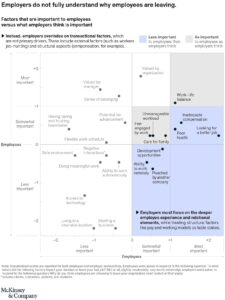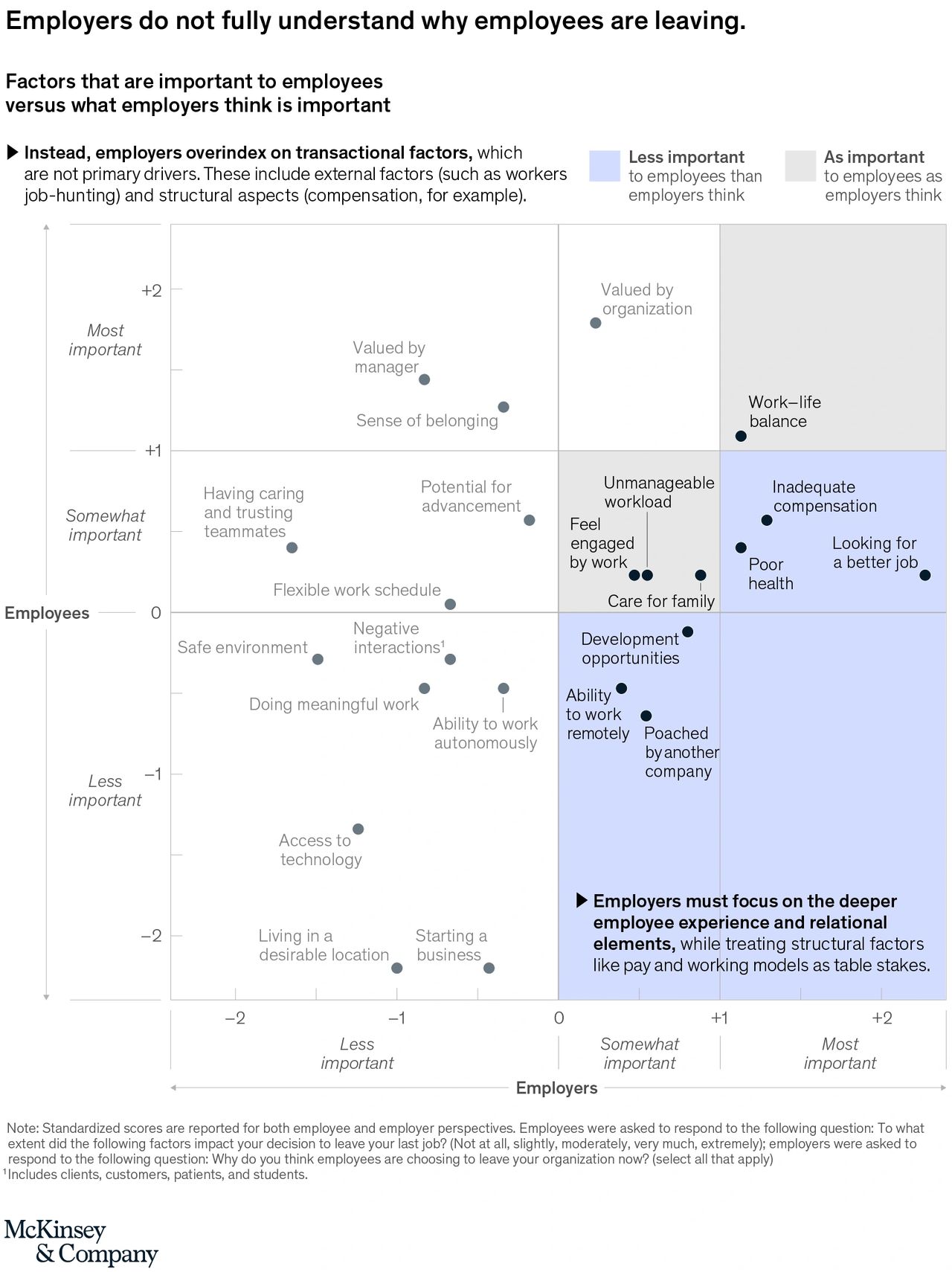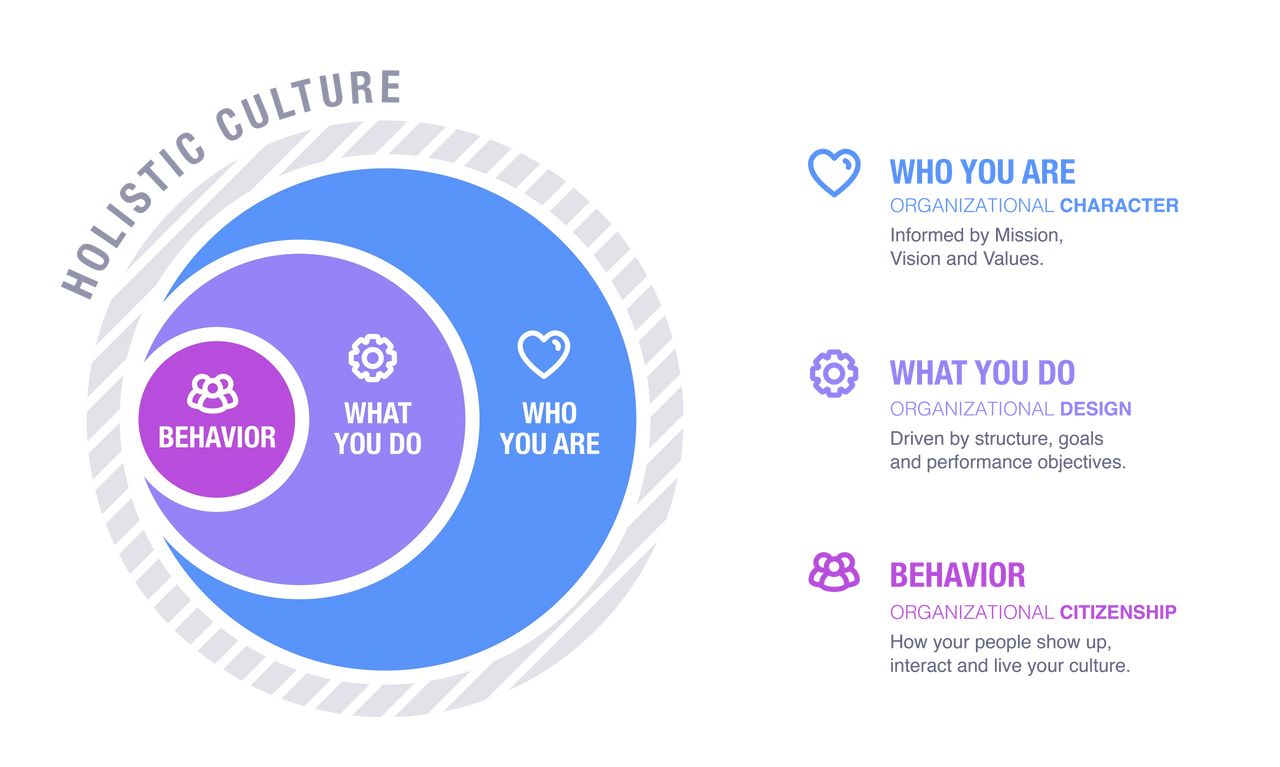Cultures of Belonging
 “By not understanding what their employees are running from, and what they might gravitate to, company leaders are putting their very business at risk”
“By not understanding what their employees are running from, and what they might gravitate to, company leaders are putting their very business at risk”
In a recent study conducted by McKinsey, data revealed that there is a disconnect between employees and employers with regard to the cause of attrition.
Employers assigned compensation as the most meaningful factor, among a couple of others (see chart). Compensation is table stakes. You need it to be a relevant and reasonable option, but overall, the impact of more money in an effort to hire or retain someone lasts an average of just 90 days.
Two of the most important factors for employees were largely overlooked and under considered by employers, and those were a sense of belonging and being valued by their manager. In other words, employees ranked these as the most important factors, and employers rated these among the least important.
So let’s talk about belonging…
In another study conducted by think-tank Coqual, employees who felt a high sense of belonging were more engaged with their work, planned to stay at their job for at least two years, and felt very loyal to their company. Those experiencing "low belonging" were four times more likely to say they felt stalled in their careers.
At Lead for Culture, we measure Belonging using the following dimensions of culture:
- Appreciation - Which is applied to a range, not just tangible rewards and recognition, but also feeling seen and respected by colleagues, or feeling as though one has a meaningful presence on their team.
- Connection - Meaningful professional and social interactions with peers and managers; relationships that matter to someone.
- Affinity - When employees feel valued, and when they feel their own sense of purpose and values align with their employer, a deeper bond between employee and employer takes place, it becomes part of someone.
If you are an employer reading this, it all sounds intuitive and makes sense, but you also realize this is a massive lift. This is why culture is a relentless, everyday endeavor. It has to be built into the fabric of everything you do. Everything you say. Everything you offer and design for employees needs to be intentional in an effort to understand and create these feelings and experiences for employees.
These three factors, and belonging on the whole, also have to be managed at multiple levels. The organization itself – the foundation of the company, senior leaders, managers, and peers all have to be included in this elaborate network for which you create and sustain a culture of belonging.
Are your values and goals in alignment?
 There are inflection points that we see in business, often related to strategy. Expanding into new markets, expanding product or service offerings, reacting to changes in the market or the world – as we saw with Covid and we are seeing again with the war in Ukraine.
There are inflection points that we see in business, often related to strategy. Expanding into new markets, expanding product or service offerings, reacting to changes in the market or the world – as we saw with Covid and we are seeing again with the war in Ukraine.
Leaders are generally diligent about anticipating and planning and adjusting for these strategic inflections. It is widely accepted in business that strategy is a fluid state and you must be nimble to stay competitive.
These types of changes can send shockwaves through a company culture, yet culture rarely gets the same amount of due diligence or strategic intention.
Too often leaders feel that their culture is evergreen. A founder’s story of mission and values, plastered on a wall that everyone can see. But the truth is that every point of inflection, strategic or otherwise, changes the culture. When your culture isn’t being managed and owned as intentionally as the rest of your business – guess what? It will eventually own you.
This is not an exhaustive list, but I want to highlight a few very common changes that can cause cultural inflection points:
- Leadership
- Growth/size
- Product/Service
The commonality being that often these changes also lead to changes in company goals and performance objectives.
I recently met with a CEO who was in her second year at the helm, having taken over for a longtime founder. In the 25 year history of the company, the founder built an incredible culture that felt like family. Everyone valued the customer as their top priority, they genuinely cared for their communities, and in the first 20 years of the business the company was a local hero. Everyone wanted to work there and be affiliated with that brand.
But in the five years prior, the company grew rapidly. Grew into new markets, tripled their headcount, experimented and picked up new product offerings, moved their headquarters and went public.
This CEO very aptly acknowledged that as their goals as a company were changing, the original company values were becoming less relevant. At best they were inauthentic, and at worst they were a barrier in driving the kind of performance she needed to be successful.
For example, in the past, the customer was always right. It was a service-oriented culture, with people being the core value. But moving forward, they really needed to embrace the mentality that the customer could actually really benefit from the education her company could provide. The customer is not always right, which is why they are a customer, they need guidance.
The employees really got lost in the evolution of their identity and this nuanced shift to what “service” meant.
Organizational Character Vs. Organizational Design
We refer to Organizational Character as the “soul” of the organization. This is what becomes of the mission, vision and values.
The Organizational Design, as you know, is made up of the nuts and bolts of people operations, functions, and the goals and objectives of the organization.
These two things have to work in harmony, they have to compliment and reinforce each other. They cannot function independently.
A company cannot say that they value family and balance, and then have goals and a structure that requires people to work 60 hours a week. That is inauthentic, it will cause ambivalence, and lead to attrition.
When companies hit these cultural inflection points, they need to sit down and assess the alignment of their character and their design, and think about the behaviors and citizenship they are trying to drive.
Values don’t have to be evergreen. They have to be authentic.
Companies regularly put out a new strategic plan every five years. Values, behaviors and cultural pillars should be evolving alongside strategy.
Revisiting the triggers of culture change:
· Leadership
- Changes in ownership and changes in the c-suite will trigger a domino effect of cultural change as new leader introduce new styles.
- Leadership changes also often come with changing performance goals and expectations.
· Growth/size
- When companies exceed 25 employees for the first time, this often requires a fundamental change to the leadership structure. A founder is often introducing a CEO or COO at this stage of growth. The small intimate dynamic has to become more inclusive and open as new personalities are welcomed.
- Major increments of growth, such as exceeding 200 employees, and then 500, also fundamentally change a company and its people from the previous dynamic.
· Product/service
- As companies expand their offering, expand their team, and also expand the skill sets, expertise and diversity of their people, they need to evolve and adjust their culture to apply to the collective, and to support the goals needed to sustain a more diverse portfolio.
Leadership Exercise:
Reflect on your current values. Are they the original company values or have they changed along the way? What behaviors would these values drive in your people? What expectations exist for someone to “live” these values at work?
Reflect on your performance objectives. What behaviors do you seek in top performers, and those that are helping your company reach its goals?
Are these working in harmony?
Let’s chat!
The Great Purpose Drought
 Over the last several months I’ve read countless stories about people leaving their jobs, or even their longtime careers, to pursue: balance, flexibility, new challenges, new skills, growth, autonomy or control, among others.
Over the last several months I’ve read countless stories about people leaving their jobs, or even their longtime careers, to pursue: balance, flexibility, new challenges, new skills, growth, autonomy or control, among others.
It may seem like from person to person their reasons are deeply personal and unique, with no common theme. But when you dig deeper and you follow the path, there is a red thread – and that is PURPOSE. Or the lack thereof.
I’d like to start referring to the “great resignation” as the “great purpose drought”!
In so many of these stories, the individual was directly or indirectly seeking greater meaning and purpose in their life. Leaving a company to start a business or learn a new skill is an example of directly and aggressively pursuing something that will present more meaning. Whereas seeking balance and flexibility are indirect or secondary triggers that ultimately leave someone with more space to pursue meaning outside of work.
Workism
The Atlantic did an interesting piece (The Religion of Workism Is Making Americans Miserable, 2019) on the coincidence of the decline of traditional faith with the rise in workism. Particularly among the educated-elite, workism is “the belief that work is not only necessary to economic production, but also the centerpiece of one’s identity and life’s purpose.”
In a Pew Research report on the epidemic of youth anxiety, 95% of teens said “having a job or career they enjoy” would be “extremely or very important” to them as an adult. This ranked higher than any other priority, including “helping other people who are in need” (81%) or getting married (47%). In summary: Meaning at work is/was more important than kindness and family.
The Glitch In The Matrix
There was something about those months that the world stopped in 2020 that caused a seismic shift in us.
Before Covid, the thought of losing a day, a week, or a whole month of productivity seemed absolutely insane and impossible.
Think about the number of vacations you have probably been on, where you chose to read and reply to work emails (I'm projecting). This is because work is so hard-wired into our identity that we really do believe that without us, without one day or week of our time, our manager/company/team would seize to function. And more importantly to the individual, if you aren’t performing that work function, who even are you?
But then the glitch happened. We saw that companies could shut down. The rules we were abiding by for so long were exposed as constructs to drive productivity and profit. No profit? No problem! Apparently, we can just press pause and print money.
What Does This Mean For Culture?
What we have now are two camps forming. Camp A is still hard-wired, like a religion, to seek purpose and meaning at work. Whereas Camp B is experiencing the awakenment of seeking meaning and purpose outside of work.
In both groups, the opportunity for employers is the same - to PROMOTE PURPOSE AND MEANING. At work AND at home.
There are four ways to feel meaning at work: job meaning, task meaning, organizational meaning, and interactional meaning. That actually gives employers a lot to work with, and even companies without traditionally inspiring or noble missions can lean into at least a couple of those.
But equally as important, employers need to make room for personal, non-work passions. Promote self-actualization. A local HQ here in Columbus, OH had a grant program for employees that would award them $4,500 to pursue a passion. The passion needed to be in alignment with one of the company values, but the usage was for something deeply meaningful and personal for the individual. Each year there was a cohort of grant winners.
One person used the fund to start their education in a completely unrelated field, while another used it to fly an immigrant, refugee parent back to their birthplace for a visit. Yet another used it to create a PSA for eating disorders and treatment options.
There is ample research to suggest that purpose supersedes money. So what if employers offered to redirect a portion of a 401k match to a passion fund, instead? Or create an FSA-like option for leisure and fulfilling activities.
I would love to hear from people with examples of some of the best purpose-promoting programs they've seen at work...



